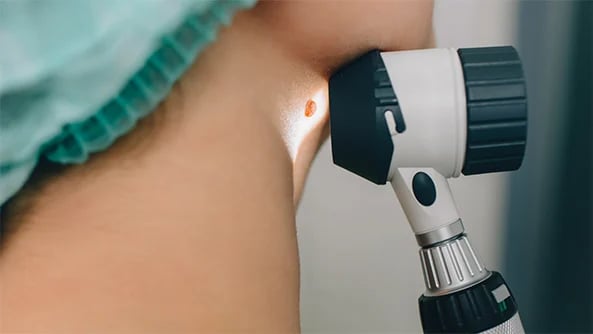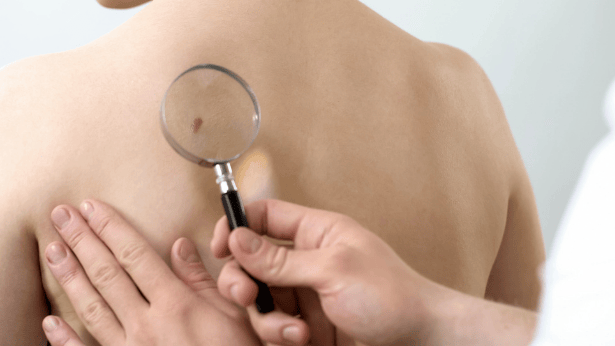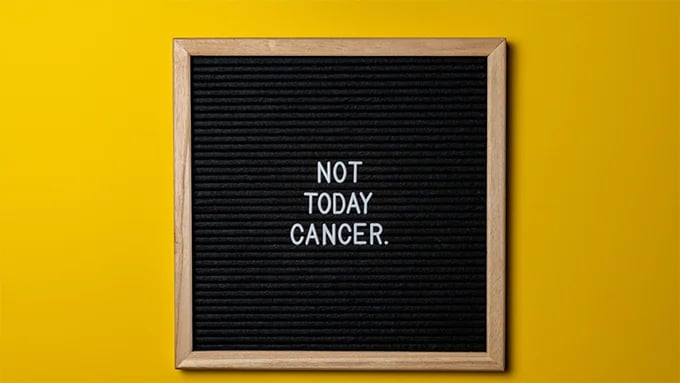Skin Cancer
What is Skin Cancer?
Skin Cancer is any form of cancer that begins on the skin. It accounts for one-third of all cancer cases, making it the most common cancer type among Canadians. Skin cancer can start on the body anywhere. This includes in between fingers, on the scalp, or the soles of the feet. There are two common skin cancers: non-melanoma and melanoma. (Canadian Skin Cancer Foundation)
Melanoma skin cancer starts in the melanocytes, the cells that produce melanin or pigment, as a malignant tumour. A malignant tumour is cells that have grown uncontrollably and can spread to other areas of the body. From here, melanoma can spread to other parts of the body as a malignant cancer. Subtypes of melanoma include: cutaneous, mucosal, and ocular. (Canadian Cancer Society; Save Your Skin Foundation)
Supporting Content
Non-melanoma skin cancer starts within the skin cells, and from there, can spread as malignant cancer to other parts of the body. There are several types of non-melanoma skin cancer, including basal cell carcinoma, squamous cell carcinoma, and merkel cell carcinoma. Carcinomas are cells that divide uncontrollably and are a type of cancer that starts in cells found in the skin or the tissue lining organs. Basal cell carcinoma makes up around 75%-80% of all skin cancer cases. (Canadian Cancer Society; Save Your Skin Foundation)
Signs and Characteristics
The symptoms of skin cancer vary depending on the type.
Melanoma
This type can occur anywhere on the body, including areas of the skin not exposed to the sun or an existing mole that turns cancerous. Melanoma can occur on anyone regardless of skin tone. How to spot melanoma during self-monitoring. (MayoClinic; Healthline):
- A brown spot with darker speckles.
- A mole that is asymmetrical or changes colour, size, feel, or bleeds.
- A lesion that causes pain, itches, or burns.
- A small lesion that has irregular borders and has portions that are red, pink, white, blue, or blueish black.
- A dark lesion on an uncommon spot such as on the palms, toes, fingernails, soles, mouth, nose, vagina, or anus.

Non-melanoma
- Merkel cell carcinoma: can appear as a small bump that resembles a pimple. Colour may vary from flesh-colour, red, purple, or bluish-red. They are tender to the touch and often appear on areas of the skin exposed to the sun. (Skin Cancer Foundation; MayoClinic)
- Basal cell carcinoma: can appear on your skin as a pearly or waxy bump, a flesh-coloured or brown lesion that is flat, or a sore that bleeds or scabs, heals, then returns. This type often appears in sun-exposed areas such as the face and neck. (Healthline; MayoClinic)
- Squamous cell carcinoma: can appear as a firm, red nodule or a flat lesion with a crusty and scaly surface. This type also often appears in sun-exposed areas such as the face and neck. (MayoClinic; Healthline)

To see photo examples for the types of skin cancer listed above and to learn more symptoms for less common skin cancers, click here.
If you have any concerns about changes in your skin or possible skin cancer, talk to your doctor immediately.
Prevention
So, what steps can be taken to help prevent skin cancer?
Some measures that can be followed include:
- Avoid sun exposure during peak times: plan outdoor activities for the early morning or evening, when the sun's rays aren't as harsh. This includes cloudy, rainy, or snowy days, as UV rays can still penetrate through clouds. UV rays can also bounce off surfaces such as sand and water, so take precautions even when in the shade.
- Wear sunscreen: although sunscreen doesn't filter out all UV rays, it does play a significant role in the overall protection from skin cancer and sun protection. Ensuring that sunscreen is broad-spectrum with an SPF of at least 30 and wearing it even on days when it's cloudy are essential. Ensure that sunscreen is being reapplied every two hours (and more often if activities with water or that cause perspiration are occurring). The lips, ears, necks and hands are often forgotten but also need sunscreen protection added to them.

- Cover exposed skin and wear a hat: scalps need to be protected too, and a broad-brimmed hat is the best, as it can also cover the face for added sun protection. Sunglasses can help protect the eyes- look for those that block both UVA and UVB rays.
- Avoid tanning beds: they produce harmful UV rays.
- Check current medications: certain medications make the skin more sensitive to sunlight. Take the extra precaution of UV exposure if taking medication that causes sun sensitivity.
- Meet with a dermatologist once a year for a skin exam, especially if you have increased risk factors.
- Self-monitor skin: checking the skin frequently can help to identify changes that occur. Everyone should self-monitor, regardless of their health history, as skin cancer can develop on anyone.
%20(1400%20%C3%97%20900%20px)%20(2).png?width=1400&height=900&name=Untitled%20(Facebook%20Post)%20(1400%20%C3%97%20900%20px)%20(2).png)
Although skin cancer has many risk factors and can occur in anyone, there are measures that can be taken to prevent it. (MayoClinic; Skin Cancer Foundation; CDC; Healthline)
Self-Monitoring 101
Who should self-monitor?
Skin cancer can be highly curable when it's caught early and treated quickly. This is why self-monitoring for skin cancer can be essential. Regardless of skin tone, health history, or age, skin cancer can happen to anyone. For this reason, everyone should incorporate self-monitoring into their monthly routine. It's recommended to self-monitor once a month and to have a specialist examine the skin yearly. (Skin Cancer Foundation)

What is monitoring?
Self-monitoring is the practice of examining your skin for any changes. Listed above in the "Signs and Characteristics" section is what to watch for when conducting a self-monitoring session. As a refresher, remember to look for any skin growths, spots, moles, or open sores that are new, changing, or unusual. Getting into the routine of self-monitoring encourages you to be an engaged patient in your health care journey by actively allowing you to take control of your health.
How to self-monitor
The steps for self-monitoring recommended by the Save Your Skin Foundation:
Step 1
Step 2
Step 3
Step 4
Step 5
Step 6
Some locations are more challenging to identify than others, which is why it's important to follow these steps when monitoring for skin cancer. When self-monitoring, if you notice any new growths or changes, contact your doctor right away. (Save Your Skin Foundation)
Treatment
After a skin cancer diagnosis, a doctor can recommend cancer care treatments. Most often, skin cancer can be treated in a dermatologist's office or outpatient surgery. However, aggressive forms of skin cancer such as melanoma skin cancer can require extensive treatments such as chemotherapy, immunotherapy, or surgery. (Canadian Cancer Society)
Surgery
Surgery is a standard treatment used to remove cells that are cancerous along with the margin of skin that surrounds them. In some instances, radiation therapy may be used after surgery or if the skin cancer returns. Radiation therapy uses a beam of radiation that is directed at cancerous cells. It's used to help remove remaining cancer cells, reduce the size of the metastases, or to relieve skin cancer symptoms. (Cancer Treatment Centers of America)
Topical Treatments
Topical treatments can include photodynamic therapy, topical chemotherapy, or an immune response modifier. Photodynamic therapy uses a photosensitive medication combined with a special blue light. For superficial skin cancers, topical chemotherapy can be used in which a chemotherapy cream is applied to the surface of the skin. Immune response modifier treatments require a special cream to be applied to the skin that activates the immune system to attack the cancer cells. (Cancer Treatment Centers of America)
Chemotherapy
For advanced skin cancer, chemotherapy can be used. Chemotherapy uses drugs administered through injection or ingested in pill form to attack skin cancer cells that have spread from the skin. (Canadian Cancer Society)
Immunotherapy
Immunotherapy is used to help strengthen and restore the immune system to help it identify and target cancerous cells. Immunotherapy is done through the use of immunotherapy drugs taken in specific doses and on a schedule designed for each individual by their health care team. Types of immunotherapy drugs include Cytokines (proteins made in a lab or by cells of the immune system) or Immune Checkpoint Inhibitors (monoclonal antibodies which attach to a specific antigen on cancer cells). (Canadian Cancer Society)
Any treatments should always be discussed with a doctor in order to determine what the best cancer care treatment plan is for each individual case. To learn more about these treatments and the types of skin cancer they treat, click here.
Living with Skin Cancer
Being diagnosed with skin cancer can leave individuals feeling stressed, anxious, and scared. Often, individuals don't even notice they have skin cancer until their diagnosis.
This is why regular self-monitoring and doctor visits are essential.
There are different stages of melanoma skin cancer that can affect how skin cancer can impact your quality of life, from what treatments are needed to how often you should visit your doctor. Here is the Save Your Skin Foundation's melanoma staging:
- Stage 0: Your doctor will examine your skin every year, but you should self-examine once a month.
- Stage IA: Your doctor will see you every three to twelve months for five years and once a year after that. You should self-examine your skin once a month.
- Stage IB, IIA, IIB, IIC: Your doctor will see you every three to six months for two years, then every three to twelve months for two more years, and once a year after that. You should self-examine your skin once a month.
To learn more about the monitoring stages, check out Save Your Skin Foundation here.
%20(1400%20%C3%97%20900%20px)%20(3).png?width=1400&height=900&name=Untitled%20(Facebook%20Post)%20(1400%20%C3%97%20900%20px)%20(3).png)
Risk Factors
Certain factors can escalate the risk of developing skin cancer. These factors include:
- Fair skin: regardless of skin tone, anyone can get skin cancer. However, there is an increased chance with people who have fair skin because there is less pigment (melanin) in the skin, which protects against damaging UV radiation.
- Having blonde or red hair, light-coloured eyes, freckles, and getting sunburnt easily: are signs of an increased risk of developing skin cancer.
- Environment: living in an area that is high-altitude or sunnier can expose people to more frequent or stronger radiation.
- UV exposure: spending time in the sun increases the risk of skin cancer, especially if the skin isn't being protected with sunscreen, clothing, or shade. Sun tanning lamps and beds using UV lights will also increase risk.
- Moles and precancerous skin lesions: both increase risk and are why regular self-monitoring for changes is crucial for early detection.
- Health history: if skin cancer has been present in either an individual's personal history or family history, it puts them at an increased risk. Additionally, a weak immune system can increase risk.
- Radiation exposure and certain substances: exposure to radiation for the therapy of explicit skin conditions can present a risk for skin cancer, specifically basal cell carcinoma. Arsenic and similar substances can also be a risk.
- Moles and precancerous skin lesions: both increase risk and are why regular self-monitoring for changes is crucial for early detection.
- Health history: if skin cancer has been present in either an individual's personal history or family history, it puts them at an increased risk. Additionally, a weak immune system can increase risk.
- Radiation exposure and certain substances: exposure to radiation for the therapy of explicit skin conditions can present a risk for skin cancer, specifically basal cell carcinoma. Arsenic and similar substances can also be a risk.
There are various factors that can lead to an increase in the risk of developing skin cancer, which is why prevention is key. (MayoClinic; CDC; Canadian Cancer Society)
Resources
We've compiled a list of resources to help you get started on your new journey
Learn about Save Your Skin Foundation:
Information about self-monitoring:
Information on Ocular Melanoma:
- National Organization for Rare Disorders (NORD) database
- Save Your Skin Foundation Ocular Melanoma page
Find community support:
Contributors:

Alexa Smith
Topic Specialist
From Our Blog
Stay up to date
%20(1)-3.png?width=940&height=788&name=Updated%20Blog%20Images%20(Blog%20listing)%20(1)-3.png)
How to Get Into the Healthy Habit of Self-Monitoring for Skin Cancer
-1.png?width=940&height=788&name=Updated%20Blog%20Images%20(Blog%20listing)-1.png)
The Importance of Taking Control of Your Own Health Care Data
%20(5)-1.png?width=940&height=788&name=Updated%20Blog%20Images%20(Blog%20listing)%20(5)-1.png)
.png?width=500&height=200&name=Zamplo%20Logo%20(1).png)
